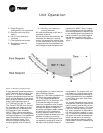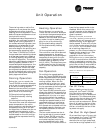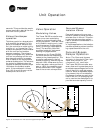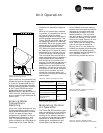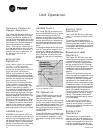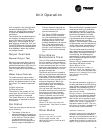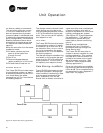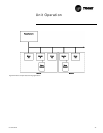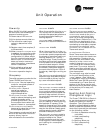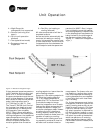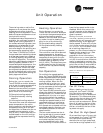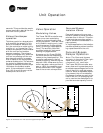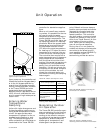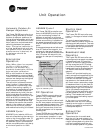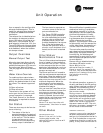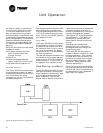
UV-SVP01A-EN 39
Power-Up
When 24 VAC is initially applied to
the controller, the following se-
quence of events occurs:
q Green status LED turns ON.
q All outputs are controlled OFF.
q The controller reads input
values to determine initial
values.
q Random-start timer expires (5
to 30 seconds).
q When POWER-UP CONTROL WAIT
is enabled, the controller waits
0-120 seconds (depending on
configuration) to allow ample
time for communicated control
data to input. If the controller
does not receive communi-
cated information, standalone
control is assumed.
q All modulating valves and
dampers calibrate closed.
q NORMAL operation begins.
Occupancy
The valid occupancy modes for the
Tracer ZN.520 controller are:
q OCCUPIED - Normal operating
mode for occupied spaces or
daytime operation.
q UNOCCUPIED - Normal
operating mode for
unoccupied spaces or
nighttime operation.
q OCCUPIED STANDBY - Mode
used to reduce the heating and
cooling demands, while
providing ventilation, during
the occupied hours when the
space is vacant or unoccupied.
q OCCUPIED BYPASS -Used to
temporarily place the unit into
the occupied operation.
The occupancy mode can be hard-
wired to the controller via the oc-
cupancy binary input or
communicated to the controller.
OCCUPIED mode
When the controller is in the OCCU-
PIED mode, the unit attempts to
maintain the space temperature at
the active occupied heating or
cooling setpoint.
OCCUPIED mode is the default
mode of the Tracer ZN.520 control-
ler.
UNOCCUPIED mode
When the controller is in the UN-
OCCUPIED mode, the unit attempts
to maintain space temperature at
the stored unoccupied heating or
cooling setpoint (i.e., config-
urable through Tracer Summit or
the Rover service tool) regardless
of the presence of a hardwired or
communicated setpoint. When
the space temperature exceeds
the stored unoccupied setpoint,
the controller brings on 100% of
the primary heating or cooling ca-
pacity.
The UNOCCUPIED mode can be ini-
tiated through a hardwired signal
to the occupancy binary input or
by a communicated request.
OCCUPIED STANDBY mode
The OCCUPIED STANDBY mode al-
lows the unit to operate at a heat-
ing or cooling setpoint between
the occupied and unoccupied set-
points to help maintain the envi-
ronment while decreasing energy
consumption.
This mode decreases the ventila-
tion for heating or cooling during
brief periods of vacancy in the
space. Unit operation in this mode
is similar to the occupied mode ex-
cept for the different heating and
cooling setpoints and a different
outside air damper position.
The OCCUPIED STANDBY mode is
initiated only when occupancy is
communicated to the Tracer
ZN.520 controller and the hard-
wired signal to the occupancy in-
put is calling for unoccupied
operation.
OCCUPIED BYPASS mode
The OCCUPIED BYPASS mode is
used to transition the unit from the
UNOCCUPIED mode to the OCCU-
PIED mode for a period of time
from 0 to 4 hours (configurable
through Rover. Default=RUN). The
controller can be placed in OCCU-
PIED BYPASS mode by either com-
municating an occupancy request
of BYPASS or by using the TIMED
OVERRIDE (i.e., ON) button on the
Trane zone sensor.
ON and CANCEL Buttons
Some Trane zone sensors have ON
and CANCEL buttons for timed over-
ride operation. Pressing the ON
button on the zone sensor when
the unit is in the UNOCCUPIED
mode initiates the OCCUPIED BY-
PASS mode and initializes the by-
pass timer. The CANCEL button is
used to send the unit back into UN-
OCCUPIED mode before the bypass
timer has expired.
The ON button may also be used
for the unit identification or the
“WINK” feature. (See “Winking”
on page38.for more information.)
When the Tracer ZN.520 controller
is connected to a Tracer Summit
system or the Rover service tool,
the ON button may be used in place
of the service pin for easy unit
identification.
Heating And Cooling
Changeover Logic
The Tracer™ ZN.520 Unit Control-
ler can receive communicated re-
quests for heating or cooling
operation. The communicated
variable nviApplicMode is used to
communicate the requests for the
controller's operating mode based
on the following values:
0 = Auto (mode determined by
controller)
1 = Heat (uses heating
setpoints)
2 = Morning Warm-up
3 = Cool (uses cooling
setpoints)
Unit Operation



